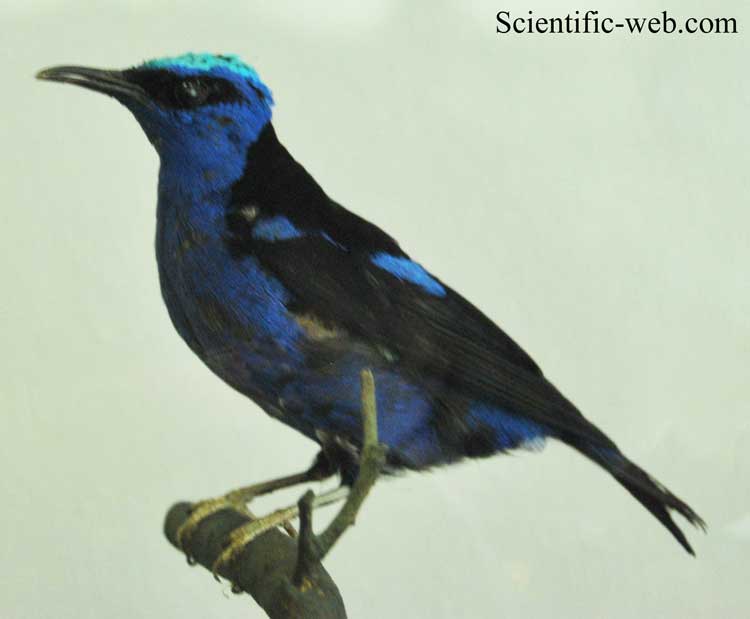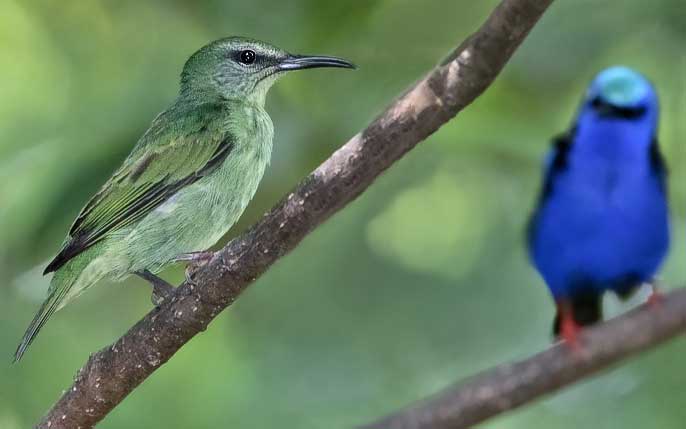Cyanerpes cyaneus, Photo: Michael Lahanas Cladus: Eukaryota
Cyanerpes cyaneus, Red-legged Honeycreeper, female and male (*)
Name Cyanerpes cyaneus (Linnaeus, 1766) Vernacular names The Red-legged Honeycreeper (Cyanerpes cyaneus) is a small songbird species in the tanager family (Thraupidae). It is found in the tropical New World from southern Mexico south to Peru, Bolivia and central Brazil, Trinidad and Tobago, and on Cuba, where possibly introduced. Description The Red-legged Honeycreeper is on average 12.2 cm long, weighs 14 g and has a medium-long black, slightly decurved, bill. The male is violet-blue with black wings, tail and back, and bright red legs. The crown of its head is turquoise, and the underwing, visible only in flight, is lemon yellow. After the breeding season, the male moults into an eclipse plumage, mainly greenish with black wings. Females and immatures are mainly green, with paler, faintly streaked underparts. The legs are red-brown in the female, and brown in young birds. The call of Red-legged Honeycreeper is a thin, high-pitched tsip. Several subspecies are known. Differences are generally slight, with the Tobago race C. c. tobagensis being slightly larger than the mainland forms for example. The Purplish Honeycreeper (Chlorophanes purpurascens), a bird from Venezuela known only from the type specimen, is considered to be an intergeneric hybrid between the Green Honeycreeper and either the Red-legged Honeycreeper or the Blue Dacnis.[1] This is a species of forest edge, open woodland, and cocoa and citrus plantations. The Red-legged Honeycreeper is often found in small groups. It feeds on insects and some fruit[2] and nectar.[3] It responds readily to the (easily imitated) call of the Ferruginous Pygmy-owl (Glaucidium brasilianum). The female Red-legged Honeycreeper builds a small cup nest in a tree, and incubates the clutch of two brown-blotched white eggs for 12–13 days, with a further 14 days to fledging. A specimen studied in the Parque Nacional de La Macarena of Colombia was found to be free of blood parasites.[4] Common and widespread, the Red-legged Honeycreeper is not considered a threatened species by the IUCN[5] ^ Storer, Robert W. (1957). "The Hybrid Origin of Chlorophanes purpurascens". Auk 74 (4): 507. References Basto, Natalia; Rodríguez, Oscar A.; Marinkelle, Cornelis J.; Gutierrez, Rafael & Matta, Nubia Estela (2006): Haematozoa in birds from la Macarena National Natural Park (Colombia). Caldasia 28(2): 371-377 [English with Spanish abstract]. PDF fulltext Further reading Source: Wikipedia, Wikispecies: All text is available under the terms of the GNU Free Documentation License |
|


